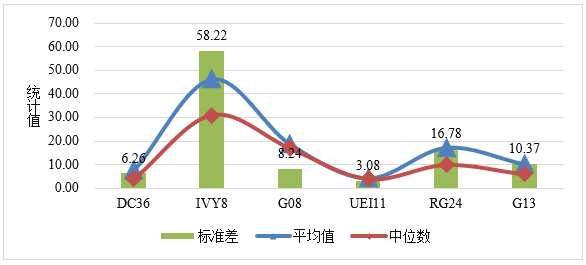 PDF(1575 KB)
PDF(1575 KB)


Status and Gaps in the Construction of World-class Universities from the Perspective of University Rankings——Comparative Analysis Based on University Groups
Chen Weijing
Knowledge Management Forum ›› 2020, Vol. 5 ›› Issue (5) : 292-304.
 PDF(1575 KB)
PDF(1575 KB)
 PDF(1575 KB)
PDF(1575 KB)
Status and Gaps in the Construction of World-class Universities from the Perspective of University Rankings——Comparative Analysis Based on University Groups
[Purpose / significance] Compare the gap between "double first-class" universities and truly first-class universities under the world standards, and provide ideas and suggestions for the "double first-class" construction. [Method / process] Based on the evaluation system of the world university rankings, taking the university group as the research object, a comprehensive comparative analysis was made between 36 “double first-class” universities in China and five typical first-class university groups in the world from the aspects of talent cultivation, scientific research, and social benefits. [Results / conclusion] The analysis results show that the values of the absolute indicators of the 36 “double-class” universities are higher than and far higher than the average of the 6 university groups, but the values of the relative indicators are all below and well below the average of the 6 university groups. In terms of talent cultivation, it is reflected that DC36 has a large number of faculty, but the faculty structure is unreasonable, and high-level talents and faculty allocation need to be improved. In terms of scientific research, it is reflected that DC36 has high scientific research output, but the quality of the paper is not high, especially the outstanding achievements are relatively few. In terms of social benefits, DC 36's international influence and the internationalization degree are not enough, the internationalization process and international exchanges need to be further strengthened.

university ranking / evaluation system / university group / world-class university
| [1] |
郭丛斌,张优良,傅翰文.世界大学排名指标体系的合理性分析——基于THE、QS和USNEWS大学排名的比较研究[J].教育评论,2018(12):9-13.
|
| [2] |
施艳萍,袁曦临,宋歌.基于ARWU的世界大学排名体系比较及实证研究[J].图书情报工作,2017,61(5):95-102.
|
| [3] |
DOBROTA M, DOBROTA M. ARWU ranking uncertainty and sensitivity: what if the award factor was excluded?[J].Journal of the Association for Information Science and Technology, 2016, 67 (2):480-482.
|
| [4] |
HUANG M H. Opening the black box of QS world university rankings[J].Research evaluation, 2012,21(1):71-78.
|
| [5] |
DOBROTA M, BULAJIC M, BORNMANN L, et al. A new approach to the QS university ranking using the composite I-distance indicator: uncertainty and sensitivity analyses[J].Journal of the Association for Information Science and Technology,2016,67(1):200-211.
|
| [6] |
VICENTE S. Inter-ranking reputational effects: an analysis of the Academic Ranking of World Universities (ARWU) and the Times Higher Education World University Rankings (THE) reputational relationship[J]. Scientometrics,2019(121):897-915.
|
| [7] |
GÜLEDA D, UMUT A. Is it possible to rank universities using fewer indicators? a study on five international university rankings[J]. Aslib journal of information management,2019,(70)1:18-37.
|
| [8] |
刘瑞儒,何海燕,李勇,等.世界一流大学评价指标结构分析及启示[J].高等工程教育研究,2017(4):90-93.
|
| [9] |
杨天平,任永灿.国内外大学评价指标体系的发展趋势[J].高教发展与评估,2014,5(30):1-11.
|
| [10] |
赵国栋,马瑞敏.世界一流大学五大评价指标体系的比较、改进及其启示[J].重庆大学学报(社会科学版),2019,25(5):111-122.
|
| [11] |
周光礼,武建鑫.什么是学术评价的全球标准——基于四个全球大学排名榜的实证分析[J].中国高教研究,2016(4):51-56.
|
| [12] |
杨清华,孙耀威,许仪.建立中国特色的世界一流大学评价体系[J].中国高等教育,2017(19):42-45.
|
| [13] |
李鹏虎.关于大学排名与我国世界一流大学建设的理性思考[J].中国高教研究,2016(6):75-79.
|
| [14] |
殷晶晶.我国创建世界一流大学路径探究——基于世界大学排名分析[J].江苏高教,2017(5):25-28.
|
| [15] |
田稷,何晓薇,余敏杰,等. C9联盟与世界一流大学联盟信息计算学特征研究[J].情报学报,2018,37(1):31-42.
|
| [16] |
何培,郑忠,何德忠,等. C9高校与世界一流大学群体学科发展比较研究——基于ESI数据库的计量分析[J].学位与研究生教育,2012(12):64-69.
|
| [17] |
Academic Ranking of World Universities. Methodology[EB/OL]. [2019-11-26]. http://www.shanghairanking.com/ARWU-Methodology-2019.html.
|
| [18] |
QS TOPUNIVERSITIES. Methodology[EB/OL].[2019-11-26]. https://www.qschina.cn/en/qs-world-university-rankings/methodology.
|
| [19] |
U.S. News. How U.S. news calculated the best global universities rankings[EB/OL]. [2019-11-26]. https://www.usnews.com/education/best-global-universities/articles/methodology.
|
| [20] |
THE World University Rankings. World University Rankings 2019: methodology[EB/OL].[2019-11-26].https://www.timeshighereducation.com/world-university-rankings/world-university-rankings-2019-methodology?site=cn.
|
| [21] |
中华人民共和国教育部.教育部 财政部 国家发展改革委印发《关于高等学校加快”双一流”建设的指导意见》的通知[EB/OL]. [2019-11-26].http://www.moe.gov.cn/srcsite/A22/moe_843/201808/t20180823_345987.html.
|
| [22] |
王兆旭,薛惠锋.基于QS和ARWU排名体系的我国工科大学与世界一流大学的差距分析[J].电子科技大学学报(社科版),2017(4):106-112.
|
| [23] |
Web of Science Group. Highly cited researchers[EB/OL].[2019-11-26]. https://recognition.webofsciencegroup.com/awards/highly-cited/2019/.
|
/
| 〈 |
|
〉 |